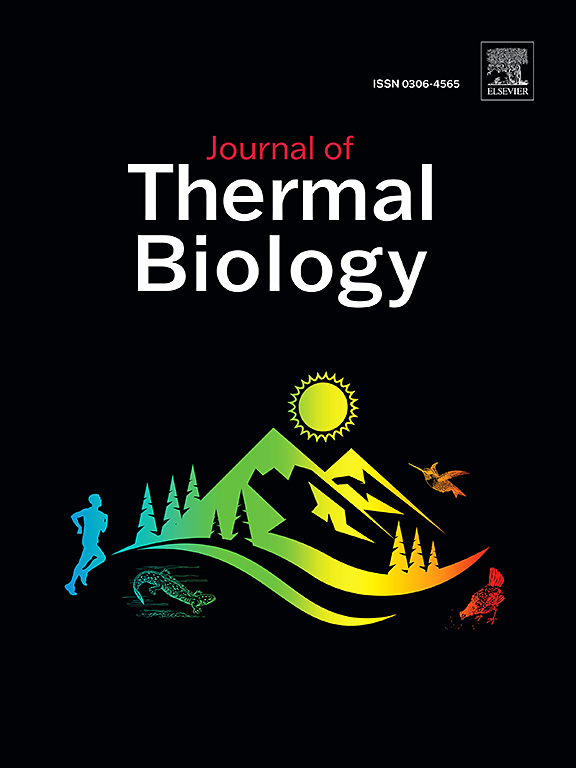Head-neck heating and fatigue: Effects on peripheral and central function and motor accuracy in healthy men and those with multiple sclerosis
IF 2.9
2区 生物学
Q2 BIOLOGY
引用次数: 0
Abstract
Objective
This study aimed to evaluate whether localized heating of the head and neck, combined with prolonged submaximal exercise at a thermoneutral temperature, would elicit peripheral and central changes in healthy men and those with multiple sclerosis (MS).
Methods
We studied the effects of head-neck heating (at 44 °C ± 0.5 °C adjacent to the skin) in men with relapsing-remitting MS (n = 16; age: 31.8 ± 7.6 years) and healthy men (n = 18; age: 27.6 ± 4.3 years). Both groups completed local heating and control trials (1-week apart) comprising 100 intermittent isometric knee extensions (5-s contraction, 20-s rest). We assessed electrically induced torque, maximal voluntary contraction (MVC), central activation ratio, muscle temperature (Tmu), perceived effort, blood stress markers, electromyography (EMG), and motor variability and accuracy. Measurements were taken at baseline, after 50 and 100 repetitions, and after 1-h recovery.
Results
Local heating inhibits central activation and reduces exercise-induced peripheral fatigue compared with non-heating conditions (p < 0.05) in men with MS. Head-neck heating led to a greater increase in Tmu during exercise in both groups. During high-intensity exercise (75 % MVC), local heating increased perceived effort in men with MS, impaired accuracy in healthy men, but did not affect EMG amplitude in either group (p < 0.05). Local heating during submaximal exercise induced greater changes in central and peripheral fatigability in men with MS than in healthy men (p < 0.05).
Conclusion
Head-neck heating during exercise suppressed central muscle activation and reduced peripheral fatigue in men with MS more than exercise performed under non-heating conditions.
头颈部发热和疲劳:对健康男性和多发性硬化症患者外周和中枢功能及运动准确性的影响
目的本研究旨在评估头部和颈部局部加热,并在热中性温度下长时间进行亚极限运动,是否会引起健康男性和多发性硬化症(MS)患者外周和中枢的变化。方法:我们研究了头颈加热(44°C±0.5°C)对复发缓解型MS男性患者的影响(n = 16;年龄:31.8±7.6岁)和健康男性(n = 18;年龄:27.6±4.3岁)。两组均完成局部加热和对照试验(间隔1周),包括100次间歇等距膝关节伸展(5-s收缩,20-s休息)。我们评估了电诱导扭矩、最大自主收缩(MVC)、中枢激活比、肌肉温度(Tmu)、感知力、血压指标、肌电图(EMG)和运动变异性和准确性。测量分别在基线、50次和100次重复以及恢复1小时后进行。结果与非加热条件相比,局部加热抑制中央激活,减轻运动引起的外周疲劳(p <;头颈加热导致两组患者运动时Tmu增加更大。在高强度运动(75% MVC)中,局部加热增加了MS患者的感知力度,损害了健康男性的准确性,但不影响两组的肌电图振幅(p <;0.05)。次大运动时局部加热对MS患者中枢和外周疲劳的影响大于健康男性(p <;0.05)。结论运动时头颈加热比非加热条件下运动更能抑制MS患者中枢肌肉的活动,减轻周围疲劳。
本文章由计算机程序翻译,如有差异,请以英文原文为准。
求助全文
约1分钟内获得全文
求助全文
来源期刊

Journal of thermal biology
生物-动物学
CiteScore
5.30
自引率
7.40%
发文量
196
审稿时长
14.5 weeks
期刊介绍:
The Journal of Thermal Biology publishes articles that advance our knowledge on the ways and mechanisms through which temperature affects man and animals. This includes studies of their responses to these effects and on the ecological consequences. Directly relevant to this theme are:
• The mechanisms of thermal limitation, heat and cold injury, and the resistance of organisms to extremes of temperature
• The mechanisms involved in acclimation, acclimatization and evolutionary adaptation to temperature
• Mechanisms underlying the patterns of hibernation, torpor, dormancy, aestivation and diapause
• Effects of temperature on reproduction and development, growth, ageing and life-span
• Studies on modelling heat transfer between organisms and their environment
• The contributions of temperature to effects of climate change on animal species and man
• Studies of conservation biology and physiology related to temperature
• Behavioural and physiological regulation of body temperature including its pathophysiology and fever
• Medical applications of hypo- and hyperthermia
Article types:
• Original articles
• Review articles
 求助内容:
求助内容: 应助结果提醒方式:
应助结果提醒方式:


